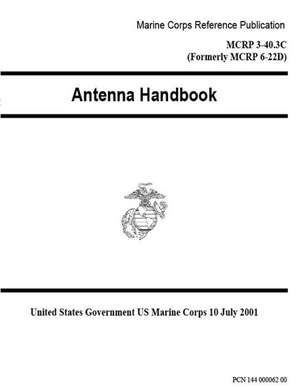Marine Corps Reference Publication McRp 3-40.3c (Formerly McRp 6-22d) Antenna Handbook 10 July 2001
Autor United States Governmen Us Marine Corpsen Limba Engleză Paperback
Preț: 97.34 lei
Nou
Puncte Express: 146
Preț estimativ în valută:
18.63€ • 19.34$ • 15.53£
18.63€ • 19.34$ • 15.53£
Carte indisponibilă temporar
Doresc să fiu notificat când acest titlu va fi disponibil:
Se trimite...
Preluare comenzi: 021 569.72.76
Specificații
ISBN-13: 9781540853387
ISBN-10: 1540853381
Pagini: 70
Dimensiuni: 216 x 280 x 4 mm
Greutate: 0.19 kg
ISBN-10: 1540853381
Pagini: 70
Dimensiuni: 216 x 280 x 4 mm
Greutate: 0.19 kg
